Cost-Effective Hyperspectral Transmissometers for Oceanographic Applications: Performance Analysis
Abstract
:1. Introduction
2. Material and Procedures
2.1. Instrument Description


Principles of Operation
2.2. Uncertainty Assessment of the Measurement System

3. Assessment
3.1. Instrument Stability
3.1.1. Instrument Precision
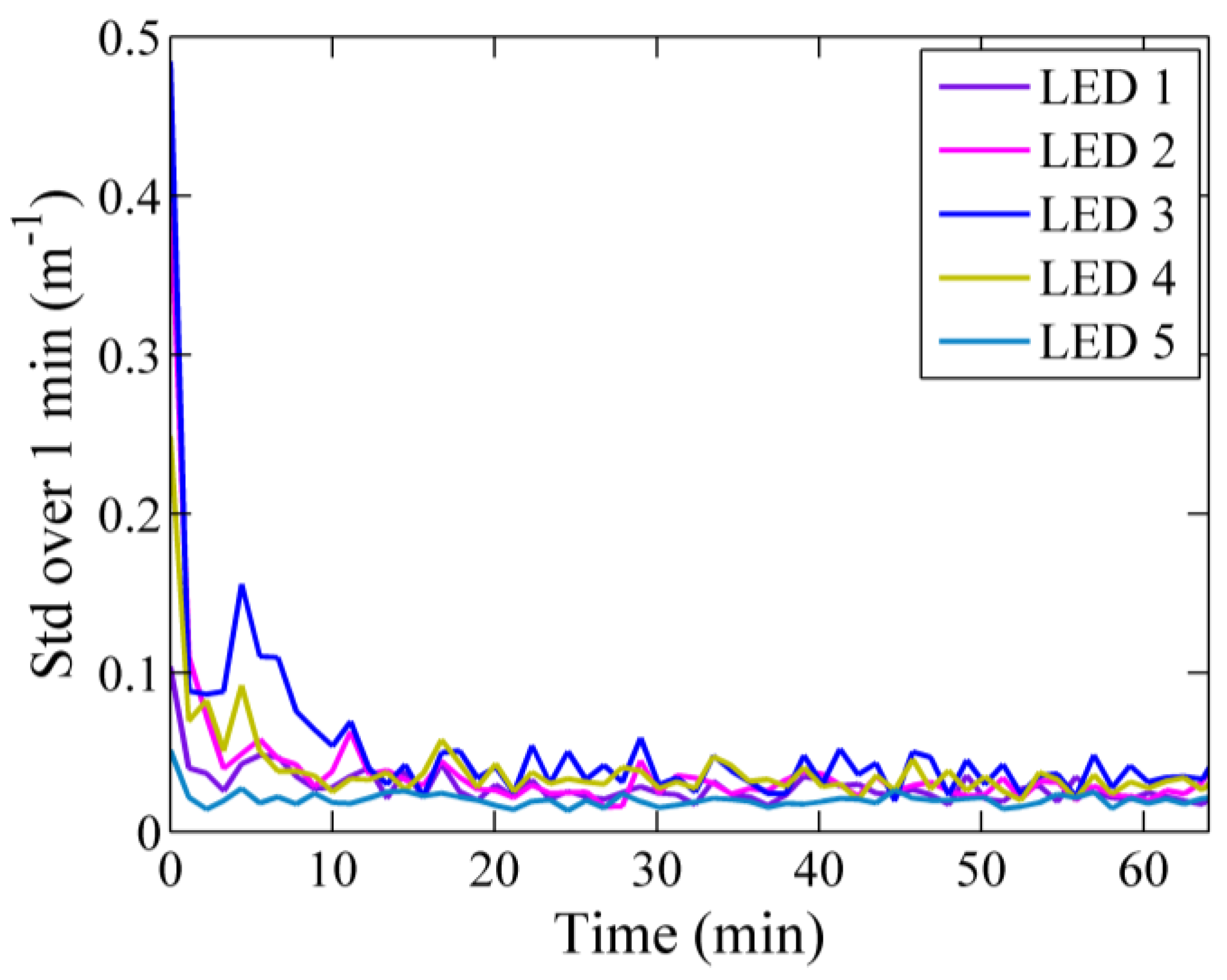
3.1.2. Thermal Management
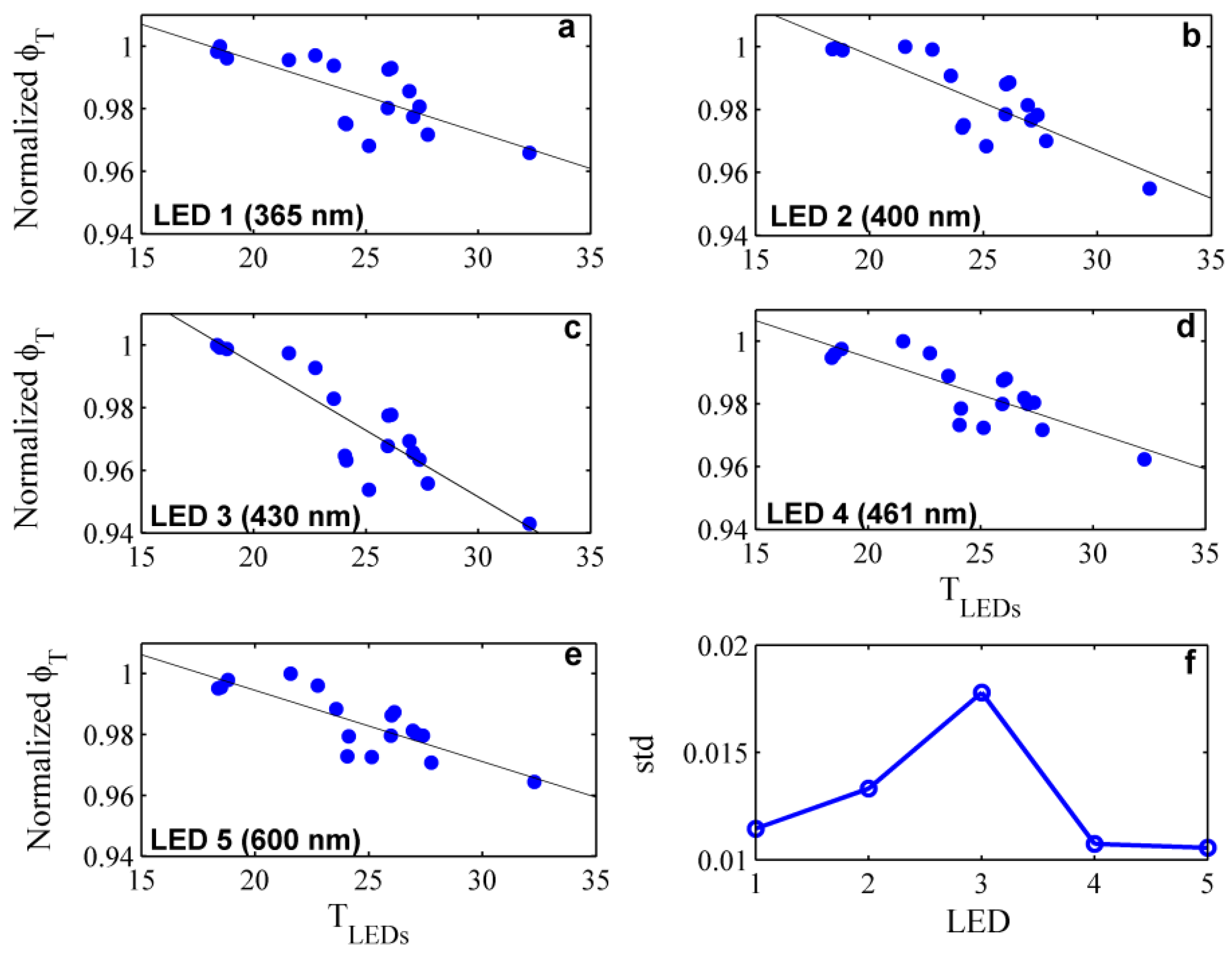
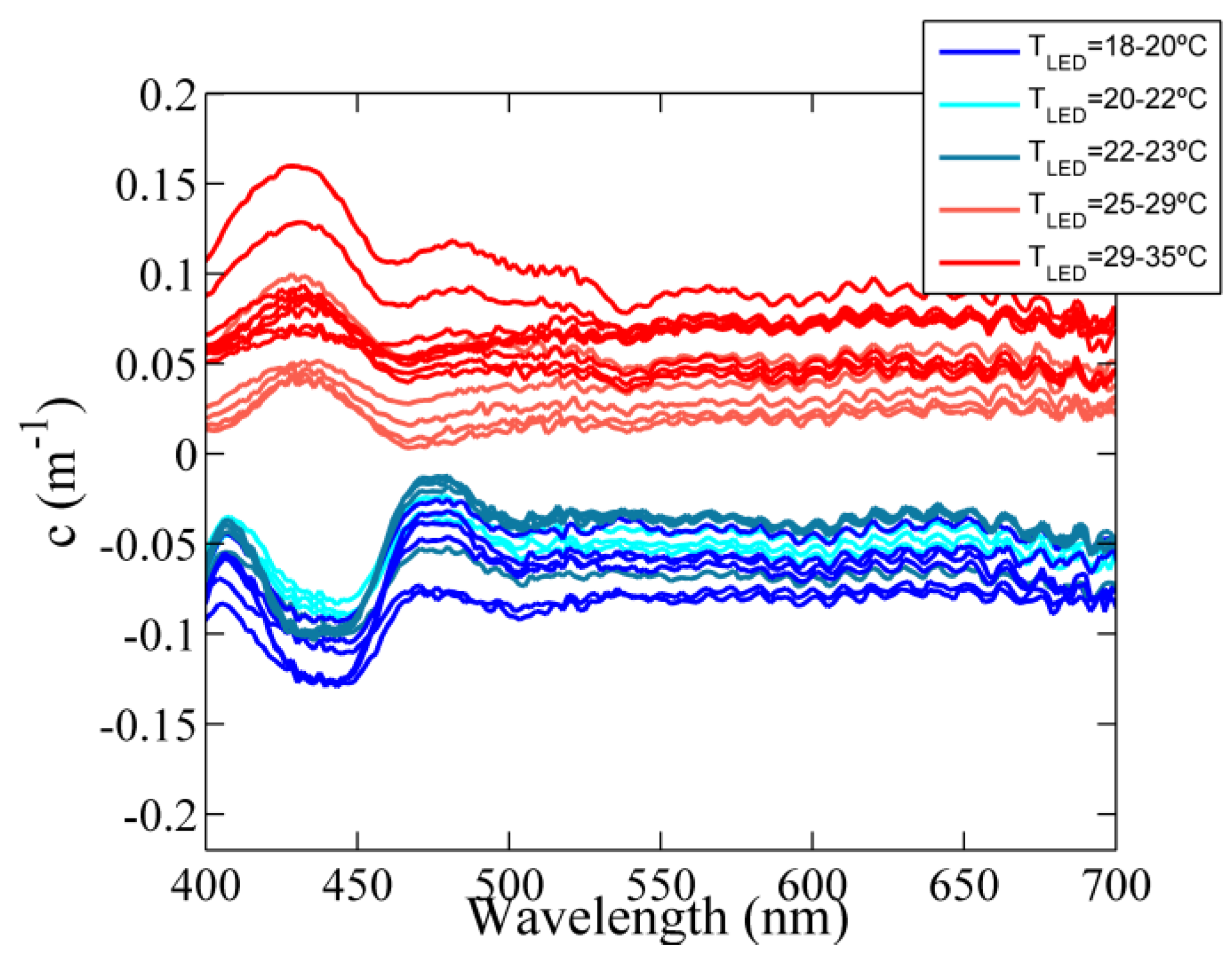
3.2. Instrument-Specific Temperature and Salinity Correction Factors
3.2.1. Temperature Correction Coefficients
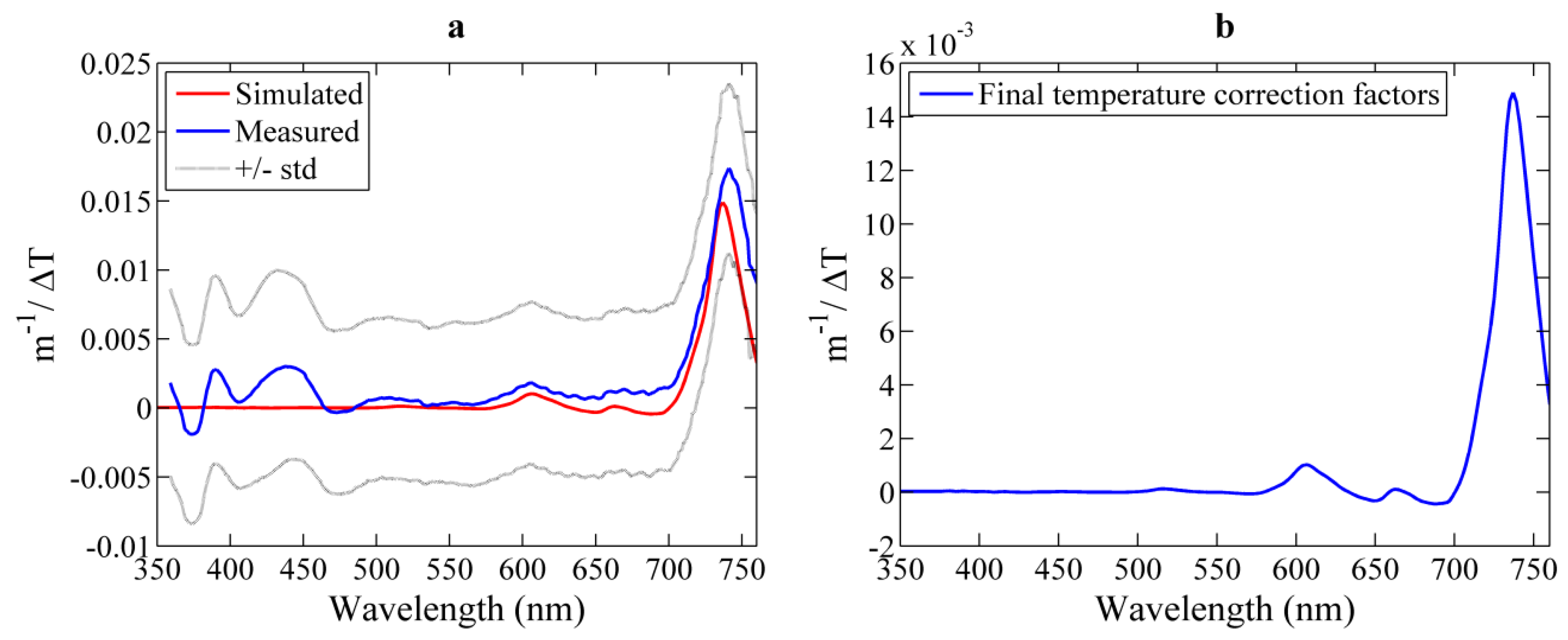
3.2.2. Salinity Correction Coefficients
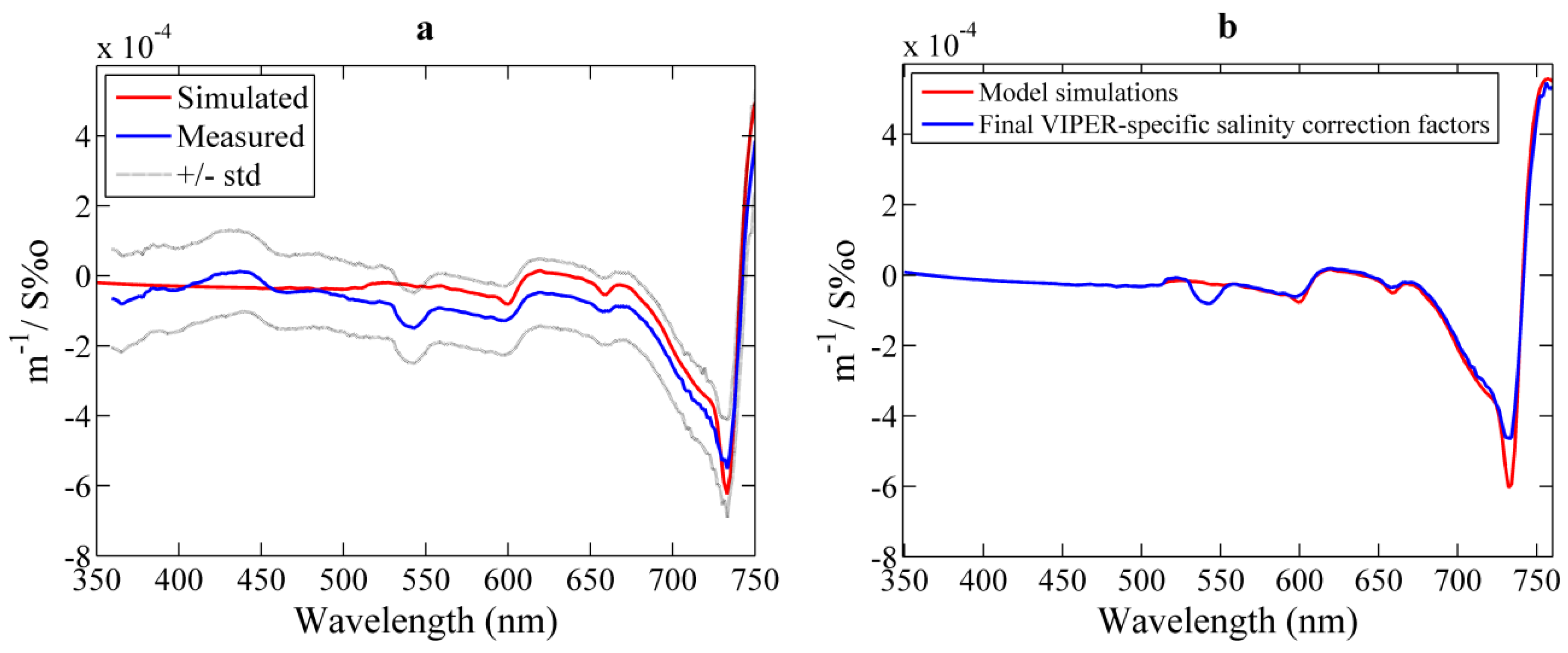
3.3. Ambient Light Effects
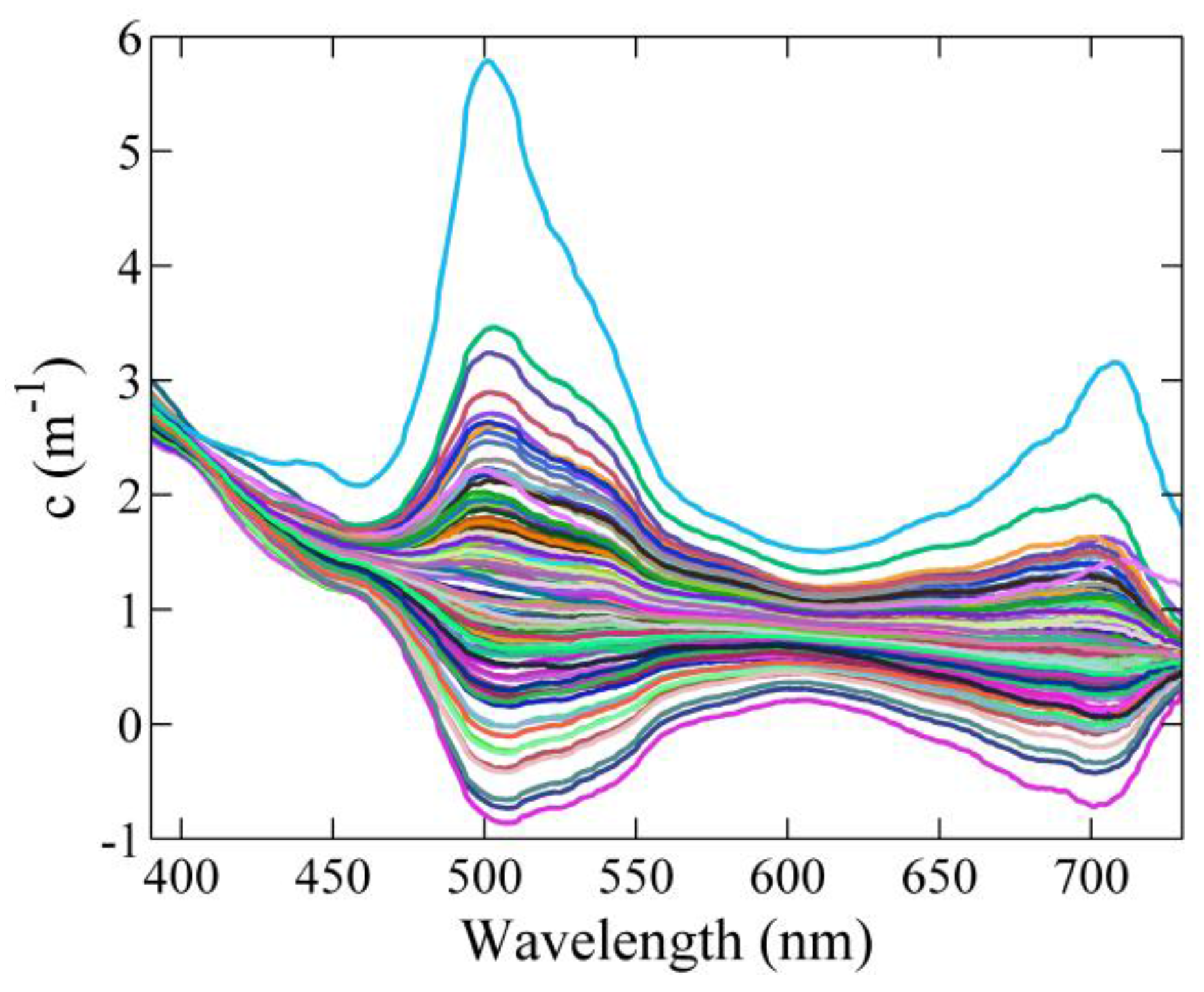
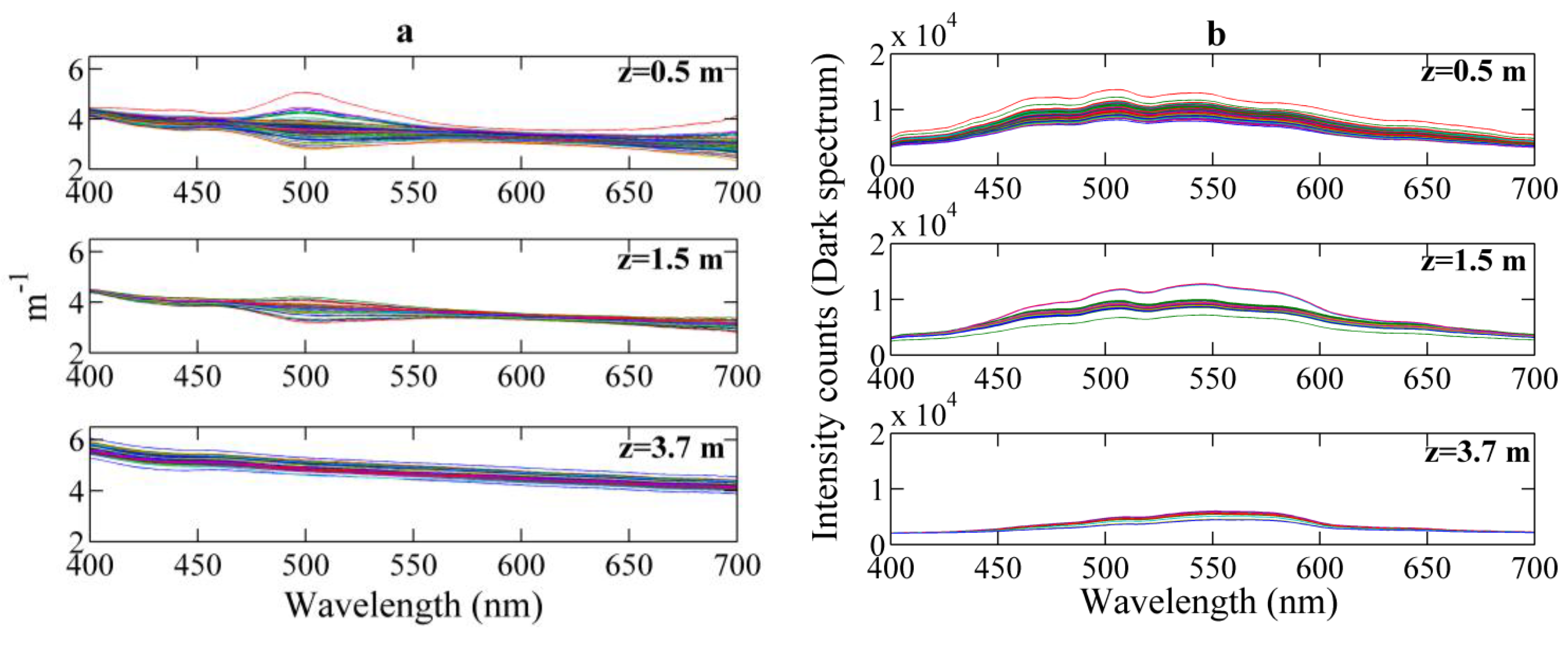
3.4. Instrument Performance during in Situ Measurements
3.4.1. VIPER vs. AC-S

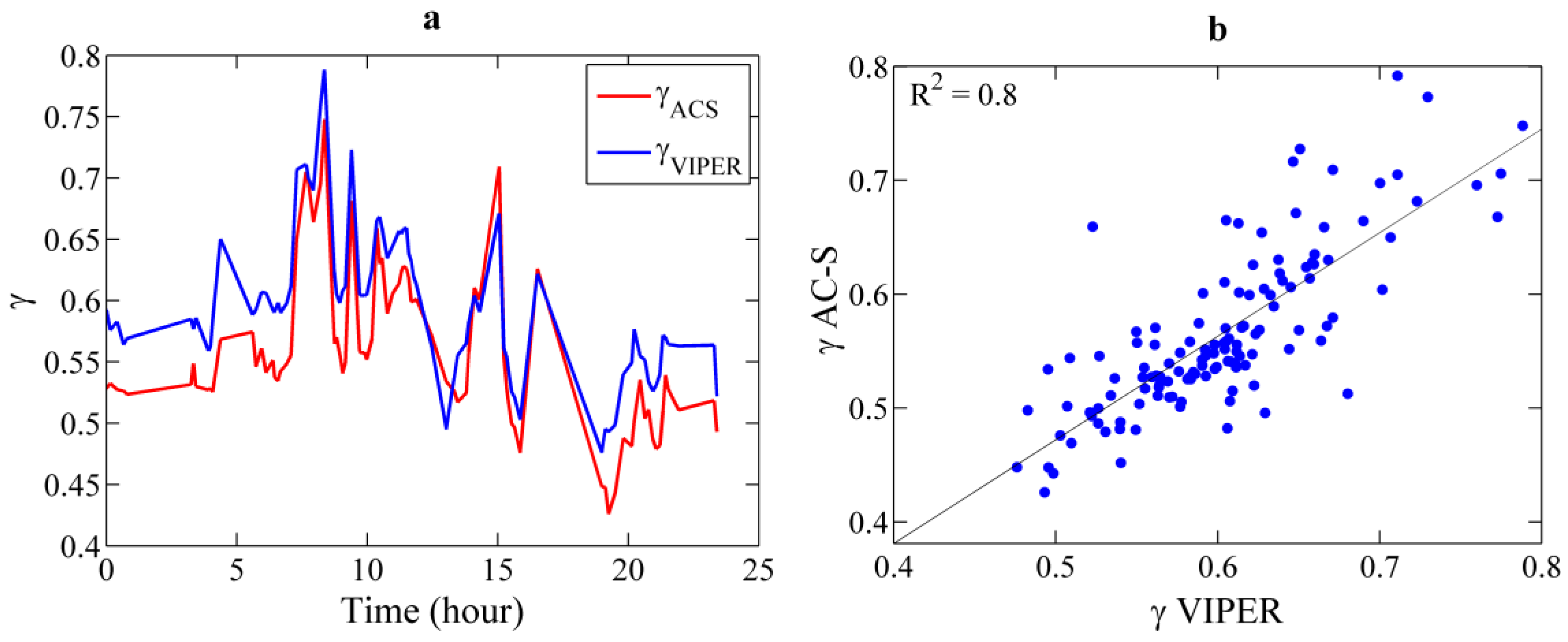
3.4.2. VIPER vs. LISST 100X
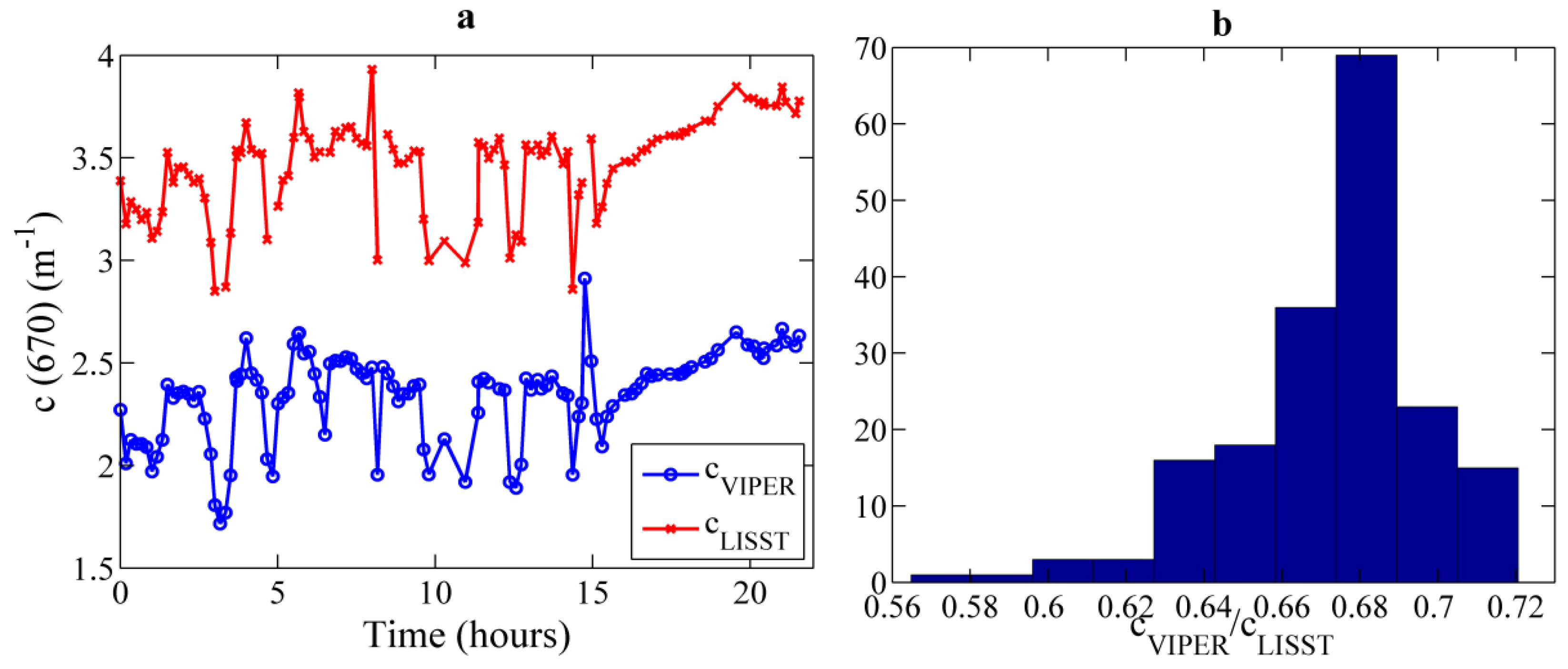
4. Discussion
5. Conclusions
Acknowledgments
Author Contributions
Conflicts of Interest
Appendix
A. Model Simulations
B. Temperature Correction Coefficients
C. Salinity Correction Coefficients
| λ | ψT | σT | ψS | σS | λ | ψT | σT | ψS | σS | λ | ψT | σT | ψS | σS |
|---|---|---|---|---|---|---|---|---|---|---|---|---|---|---|
| (nm) | (m−1·°C−1) | (m−1·°C−1) | (m−1·S−1) | (m−1·S−1) | (nm) | (m−1·°C−1) | (m−1·°C−1) | (m−1·S−1) | (m−1·S−1) | (nm) | (m−1·°C−1) | (m−1·°C−1) | (m−1·S−1) | (m−1·S−1) |
| 350 | 3.65E−05 | 7.97E−03 | −1.96E−05 | 1.67E−04 | 488 | 6.90E−07 | 7.02E−03 | −3.71E−05 | 1.02E−04 | 626 | 2.72E−04 | 6.98E−03 | 1.61E−05 | 9.59E−05 |
| 352 | 3.62E−05 | 8.04E−03 | −2.01E−05 | 1.82E−04 | 490 | 1.41E−06 | 6.99E−03 | −3.64E−05 | 1.01E−04 | 628 | 1.83E−04 | 7.00E−03 | 1.48E−05 | 9.66E−05 |
| 354 | 3.60E−05 | 7.66E−03 | −2.07E−05 | 1.51E−04 | 492 | 3.02E−06 | 6.98E−03 | −3.72E−05 | 1.01E−04 | 630 | 1.08E−04 | 6.99E−03 | 1.33E−05 | 9.51E−05 |
| 356 | 3.61E−05 | 7.68E−03 | −2.12E−05 | 1.51E−04 | 494 | 6.25E−06 | 6.92E−03 | −3.77E−05 | 1.03E−04 | 632 | 4.34E−05 | 6.92E−03 | 1.08E−05 | 9.74E−05 |
| 358 | 3.60E−05 | 7.73E−03 | −2.17E−05 | 1.43E−04 | 496 | 1.14E−05 | 6.93E−03 | −3.77E−05 | 1.04E−04 | 634 | −1.56E−05 | 6.86E−03 | 9.81E−06 | 9.54E−05 |
| 360 | 3.59E−05 | 7.83E−03 | −2.22E−05 | 1.41E−04 | 498 | 1.67E−05 | 7.03E−03 | −3.83E−05 | 1.02E−04 | 636 | −7.42E−05 | 6.83E−03 | 8.75E−06 | 9.47E−05 |
| 362 | 3.58E−05 | 7.78E−03 | −2.27E−05 | 1.41E−04 | 500 | 2.24E−05 | 6.95E−03 | −3.82E−05 | 1.02E−04 | 638 | −1.30E−04 | 6.86E−03 | 7.52E−06 | 9.69E−05 |
| 364 | 3.58E−05 | 7.69E−03 | −2.32E−05 | 1.39E−04 | 502 | 2.91E−05 | 6.88E−03 | −3.78E−05 | 1.02E−04 | 640 | −1.79E−04 | 6.87E−03 | 6.24E−06 | 9.58E−05 |
| 366 | 3.57E−05 | 7.60E−03 | −2.36E−05 | 1.36E−04 | 504 | 3.77E−05 | 6.85E−03 | −3.57E−05 | 1.04E−04 | 642 | −2.16E−04 | 6.87E−03 | 1.20E−06 | 9.39E−05 |
| 368 | 3.55E−05 | 7.57E−03 | −2.41E−05 | 1.33E−04 | 506 | 4.96E−05 | 6.94E−03 | −3.40E−05 | 1.00E−04 | 644 | −2.46E−04 | 6.85E−03 | −2.18E−06 | 9.62E−05 |
| 370 | 3.55E−05 | 7.62E−03 | −2.45E−05 | 1.31E−04 | 508 | 6.65E−05 | 6.94E−03 | −3.43E−05 | 1.03E−04 | 646 | −2.79E−04 | 6.85E−03 | −5.50E−06 | 9.78E−05 |
| 372 | 3.54E−05 | 7.62E−03 | −2.49E−05 | 1.29E−04 | 510 | 8.75E−05 | 6.92E−03 | −3.46E−05 | 1.06E−04 | 648 | −3.07E−04 | 6.83E−03 | −8.78E−06 | 9.50E−05 |
| 374 | 3.54E−05 | 7.70E−03 | −2.53E−05 | 1.32E−04 | 512 | 1.08E−04 | 6.90E−03 | −3.36E−05 | 1.04E−04 | 650 | −3.16E−04 | 6.89E−03 | −1.07E−05 | 9.54E−05 |
| 376 | 3.64E−05 | 7.59E−03 | −2.57E−05 | 1.26E−04 | 514 | 1.22E−04 | 6.89E−03 | −2.83E−05 | 9.80E−05 | 652 | −2.95E−04 | 6.93E−03 | −1.74E−05 | 9.50E−05 |
| 378 | 4.32E−05 | 7.62E−03 | −2.61E−05 | 1.22E−04 | 516 | 1.28E−04 | 6.87E−03 | −2.48E−05 | 1.01E−04 | 654 | −2.38E−04 | 6.92E−03 | −2.61E−05 | 9.46E−05 |
| 380 | 4.91E−05 | 7.79E−03 | −2.65E−05 | 1.26E−04 | 518 | 1.24E−04 | 6.92E−03 | −2.24E−05 | 9.97E−05 | 656 | −1.46E−04 | 6.90E−03 | −3.21E−05 | 9.65E−05 |
| 382 | 4.72E−05 | 7.68E−03 | −2.68E−05 | 1.20E−04 | 520 | 1.15E−04 | 6.89E−03 | −2.19E−05 | 9.95E−05 | 658 | −3.56E−05 | 6.91E−03 | −3.61E−05 | 9.51E−05 |
| 384 | 3.69E−05 | 7.80E−03 | −2.72E−05 | 1.25E−04 | 522 | 1.02E−04 | 6.87E−03 | −2.10E−05 | 1.03E−04 | 660 | 5.61E−05 | 6.97E−03 | −3.27E−05 | 9.58E−05 |
| 386 | 3.47E−05 | 7.82E−03 | −2.75E−05 | 1.22E−04 | 524 | 8.97E−05 | 6.89E−03 | −1.98E−05 | 1.03E−04 | 662 | 1.03E−04 | 7.04E−03 | −3.23E−05 | 9.77E−05 |
| 388 | 4.04E−05 | 7.88E−03 | −2.78E−05 | 1.20E−04 | 526 | 7.70E−05 | 6.85E−03 | −1.99E−05 | 1.00E−04 | 664 | 1.01E−04 | 6.99E−03 | −2.40E−05 | 9.87E−05 |
| 390 | 4.48E−05 | 7.88E−03 | −2.82E−05 | 1.23E−04 | 528 | 6.41E−05 | 6.86E−03 | −1.31E−05 | 1.01E−04 | 666 | 6.84E−05 | 6.95E−03 | −1.91E−05 | 9.83E−05 |
| 392 | 4.04E−05 | 7.83E−03 | −2.85E−05 | 1.24E−04 | 530 | 5.13E−05 | 6.90E−03 | −1.93E−05 | 9.72E−05 | 668 | 2.13E−05 | 6.97E−03 | −2.19E−05 | 9.56E−05 |
| 394 | 3.35E−05 | 7.72E−03 | −2.88E−05 | 1.23E−04 | 532 | 3.96E−05 | 6.84E−03 | −4.23E−05 | 1.01E−04 | 670 | −2.98E−05 | 7.06E−03 | −2.06E−05 | 9.60E−05 |
| 396 | 2.89E−05 | 7.62E−03 | −2.90E−05 | 1.21E−04 | 534 | 3.01E−05 | 6.82E−03 | −5.71E−05 | 9.96E−05 | 672 | −9.00E−05 | 7.18E−03 | −2.08E−05 | 9.58E−05 |
| 398 | 2.68E−05 | 7.51E−03 | −2.93E−05 | 1.19E−04 | 536 | 2.30E−05 | 6.73E−03 | −6.82E−05 | 1.02E−04 | 674 | −1.62E−04 | 7.16E−03 | −2.59E−05 | 1.00E−04 |
| 400 | 2.75E−05 | 7.41E−03 | −2.96E−05 | 1.19E−04 | 538 | 1.75E−05 | 6.70E−03 | −7.55E−05 | 1.01E−04 | 676 | −2.38E−04 | 7.03E−03 | −3.18E−05 | 9.64E−05 |
| 402 | 2.88E−05 | 7.37E−03 | −2.98E−05 | 1.17E−04 | 540 | 1.31E−05 | 6.74E−03 | −7.83E−05 | 1.02E−04 | 678 | −3.01E−04 | 7.06E−03 | −4.07E−05 | 9.74E−05 |
| 404 | 2.65E−05 | 7.38E−03 | −3.01E−05 | 1.16E−04 | 542 | 8.29E−06 | 6.77E−03 | −8.14E−05 | 1.01E−04 | 680 | −3.44E−04 | 7.07E−03 | −5.15E−05 | 9.60E−05 |
| 406 | 1.85E−05 | 7.40E−03 | −3.03E−05 | 1.14E−04 | 544 | 3.65E−06 | 6.76E−03 | −7.95E−05 | 1.01E−04 | 682 | −3.75E−04 | 7.13E−03 | −5.85E−05 | 9.86E−05 |
| 408 | 1.11E−05 | 7.43E−03 | −3.06E−05 | 1.16E−04 | 546 | 2.16E−07 | 6.87E−03 | −7.22E−05 | 9.94E−05 | 684 | −4.02E−04 | 7.12E−03 | −6.83E−05 | 9.57E−05 |
| 410 | 1.00E−05 | 7.51E−03 | −3.08E−05 | 1.14E−04 | 548 | −4.10E−07 | 6.93E−03 | −6.26E−05 | 9.75E−05 | 686 | −4.23E−04 | 7.20E−03 | −8.13E−05 | 9.66E−05 |
| 412 | 1.66E−05 | 7.57E−03 | −3.10E−05 | 1.15E−04 | 550 | 5.78E−07 | 6.93E−03 | −5.18E−05 | 9.98E−05 | 688 | −4.31E−04 | 7.14E−03 | −9.46E−05 | 9.84E−05 |
| 414 | 2.39E−05 | 7.68E−03 | −3.13E−05 | 1.16E−04 | 552 | 6.73E−08 | 6.97E−03 | −3.79E−05 | 9.75E−05 | 690 | −4.25E−04 | 7.05E−03 | −1.08E−04 | 1.01E−04 |
| 416 | 2.45E−05 | 7.74E−03 | −3.15E−05 | 1.17E−04 | 554 | −3.81E−06 | 7.01E−03 | −3.13E−05 | 9.72E−05 | 692 | −4.14E−04 | 7.04E−03 | −1.21E−04 | 1.00E−04 |
| 418 | 1.95E−05 | 7.85E−03 | −3.17E−05 | 1.18E−04 | 556 | −1.09E−05 | 7.04E−03 | −2.75E−05 | 9.80E−05 | 694 | −4.00E−04 | 7.03E−03 | −1.39E−04 | 1.00E−04 |
| 420 | 1.31E−05 | 7.95E−03 | −3.19E−05 | 1.19E−04 | 558 | −1.87E−05 | 7.05E−03 | −2.49E−05 | 9.84E−05 | 696 | −3.52E−04 | 7.15E−03 | −1.57E−04 | 9.78E−05 |
| 422 | 8.85E−06 | 8.02E−03 | −3.21E−05 | 1.21E−04 | 560 | −2.68E−05 | 7.00E−03 | −2.63E−05 | 9.86E−05 | 698 | −2.19E−04 | 7.19E−03 | −1.69E−04 | 1.02E−04 |
| 424 | 5.62E−06 | 8.12E−03 | −3.23E−05 | 1.22E−04 | 562 | −3.46E−05 | 7.05E−03 | −2.85E−05 | 1.02E−04 | 700 | −2.83E−05 | 7.13E−03 | −1.91E−04 | 1.00E−04 |
| 426 | 2.30E−06 | 8.16E−03 | −3.24E−05 | 1.21E−04 | 564 | −4.22E−05 | 7.09E−03 | −2.90E−05 | 9.73E−05 | 702 | 1.99E−04 | 7.08E−03 | −2.10E−04 | 9.80E−05 |
| 428 | 3.14E−07 | 8.22E−03 | −3.26E−05 | 1.22E−04 | 566 | −4.86E−05 | 7.09E−03 | −2.96E−05 | 9.76E−05 | 704 | 4.58E−04 | 6.97E−03 | −2.24E−04 | 1.01E−04 |
| 430 | 1.75E−06 | 8.19E−03 | −3.28E−05 | 1.21E−04 | 568 | −5.31E−05 | 7.04E−03 | −3.18E−05 | 9.87E−05 | 706 | 7.94E−04 | 6.93E−03 | −2.36E−04 | 9.53E−05 |
| 432 | 5.75E−06 | 8.14E−03 | −3.30E−05 | 1.20E−04 | 570 | −5.59E−05 | 7.01E−03 | −3.45E−05 | 9.89E−05 | 708 | 1.22E−03 | 6.99E−03 | −2.60E−04 | 1.04E−04 |
| 434 | 9.88E−06 | 8.04E−03 | −3.31E−05 | 1.18E−04 | 572 | −5.59E−05 | 7.03E−03 | −3.65E−05 | 9.80E−05 | 710 | 1.73E−03 | 6.90E−03 | −2.61E−04 | 1.05E−04 |
| 436 | 1.28E−05 | 7.92E−03 | −3.33E−05 | 1.18E−04 | 574 | −5.02E−05 | 7.03E−03 | −3.75E−05 | 9.73E−05 | 712 | 2.34E−03 | 6.94E−03 | −2.87E−04 | 1.08E−04 |
| 438 | 1.40E−05 | 7.82E−03 | −3.34E−05 | 1.15E−04 | 576 | −3.77E−05 | 6.97E−03 | −4.01E−05 | 9.88E−05 | 714 | 3.01E−03 | 6.92E−03 | −2.93E−04 | 1.08E−04 |
| 440 | 1.49E−05 | 7.75E−03 | −3.36E−05 | 1.13E−04 | 578 | −1.68E−05 | 6.94E−03 | −4.33E−05 | 9.92E−05 | 716 | 3.70E−03 | 6.77E−03 | −2.99E−04 | 1.09E−04 |
| 442 | 1.57E−05 | 7.68E−03 | −3.38E−05 | 1.14E−04 | 580 | 1.43E−05 | 6.96E−03 | −4.50E−05 | 9.84E−05 | 718 | 4.39E−03 | 6.92E−03 | −3.16E−04 | 1.02E−04 |
| 444 | 1.70E−05 | 7.63E−03 | −3.39E−05 | 1.12E−04 | 582 | 5.65E−05 | 6.96E−03 | −4.59E−05 | 9.74E−05 | 720 | 5.10E−03 | 6.93E−03 | −3.22E−04 | 1.13E−04 |
| 446 | 1.92E−05 | 7.54E−03 | −3.40E−05 | 1.12E−04 | 584 | 1.06E−04 | 6.92E−03 | −4.92E−05 | 9.71E−05 | 722 | 5.84E−03 | 7.01E−03 | −3.37E−04 | 1.04E−04 |
| 448 | 2.29E−05 | 7.46E−03 | −3.49E−05 | 1.12E−04 | 586 | 1.58E−04 | 6.92E−03 | −5.27E−05 | 9.83E−05 | 724 | 6.72E−03 | 6.98E−03 | −3.63E−04 | 1.22E−04 |
| 450 | 2.68E−05 | 7.38E−03 | −3.55E−05 | 1.12E−04 | 588 | 2.11E−04 | 6.94E−03 | −5.22E−05 | 9.75E−05 | 726 | 7.88E−03 | 6.86E−03 | −3.81E−04 | 1.14E−04 |
| 452 | 2.83E−05 | 7.30E−03 | −3.56E−05 | 1.12E−04 | 590 | 2.68E−04 | 6.96E−03 | −5.11E−05 | 9.81E−05 | 728 | 9.37E−03 | 6.58E−03 | −4.23E−04 | 1.10E−04 |
| 454 | 2.57E−05 | 7.20E−03 | −3.56E−05 | 1.08E−04 | 592 | 3.37E−04 | 6.98E−03 | −5.45E−05 | 9.74E−05 | 730 | 1.11E−02 | 6.64E−03 | −4.60E−04 | 1.23E−04 |
| 456 | 2.15E−05 | 7.10E−03 | −3.63E−05 | 1.08E−04 | 594 | 4.23E−04 | 6.96E−03 | −5.87E−05 | 9.82E−05 | 732 | 1.28E−02 | 6.42E−03 | −4.63E−04 | 1.22E−04 |
| 458 | 1.86E−05 | 7.04E−03 | −3.68E−05 | 1.06E−04 | 596 | 5.29E−04 | 6.96E−03 | −6.05E−05 | 9.91E−05 | 734 | 1.41E−02 | 6.27E−03 | −4.63E−04 | 1.25E−04 |
| 460 | 1.79E−05 | 7.00E−03 | −3.64E−05 | 1.06E−04 | 598 | 6.54E−04 | 7.00E−03 | −6.12E−05 | 9.82E−05 | 736 | 1.47E−02 | 6.59E−03 | −3.83E−04 | 1.39E−04 |
| 462 | 1.73E−05 | 6.96E−03 | −3.61E−05 | 1.05E−04 | 600 | 7.85E−04 | 7.01E−03 | −5.75E−05 | 9.80E−05 | 738 | 1.47E−02 | 6.65E−03 | −2.81E−04 | 1.34E−04 |
| 464 | 1.47E−05 | 6.98E−03 | −3.51E−05 | 1.05E−04 | 602 | 9.02E−04 | 7.00E−03 | −5.15E−05 | 9.89E−05 | 740 | 1.42E−02 | 6.43E−03 | −1.38E−04 | 1.40E−04 |
| 466 | 1.10E−05 | 7.01E−03 | −3.42E−05 | 1.04E−04 | 604 | 9.86E−04 | 6.98E−03 | −4.21E−05 | 9.84E−05 | 742 | 1.33E−02 | 6.64E−03 | 1.10E−05 | 1.55E−04 |
| 468 | 7.32E−06 | 7.06E−03 | −3.39E−05 | 1.04E−04 | 606 | 1.02E−03 | 7.03E−03 | −2.92E−05 | 9.82E−05 | 744 | 1.22E−02 | 6.64E−03 | 1.76E−04 | 1.49E−04 |
| 470 | 5.42E−06 | 7.08E−03 | −3.50E−05 | 1.06E−04 | 608 | 1.00E−03 | 7.09E−03 | −1.34E−05 | 9.82E−05 | 746 | 1.10E−02 | 6.55E−03 | 2.85E−04 | 1.24E−04 |
| 472 | 4.59E−06 | 7.11E−03 | −3.60E−05 | 1.05E−04 | 610 | 9.45E−04 | 7.09E−03 | −9.97E−07 | 9.73E−05 | 748 | 9.85E−03 | 6.20E−03 | 3.69E−04 | 1.83E−04 |
| 474 | 5.01E−06 | 7.12E−03 | −3.58E−05 | 1.05E−04 | 612 | 8.60E−04 | 7.04E−03 | 8.09E−06 | 9.71E−05 | 750 | 8.69E−03 | 6.43E−03 | 4.46E−04 | 1.43E−04 |
| 476 | 6.08E−06 | 7.16E−03 | −3.55E−05 | 1.05E−04 | 614 | 7.74E−04 | 7.00E−03 | 1.20E−05 | 9.82E−05 | 752 | 7.57E−03 | 6.54E−03 | 5.09E−04 | 1.60E−04 |
| 478 | 6.93E−06 | 7.15E−03 | −3.48E−05 | 1.05E−04 | 616 | 6.95E−04 | 7.03E−03 | 1.54E−05 | 9.69E−05 | 754 | 6.46E−03 | 6.35E−03 | 5.08E−04 | 1.44E−04 |
| 480 | 6.94E−06 | 7.13E−03 | −3.58E−05 | 1.06E−04 | 618 | 6.22E−04 | 7.09E−03 | 1.87E−05 | 9.66E−05 | 756 | 5.37E−03 | 7.33E−03 | 5.47E−04 | 1.53E−04 |
| 482 | 5.17E−06 | 7.08E−03 | −3.79E−05 | 1.03E−04 | 620 | 5.44E−04 | 7.09E−03 | 1.98E−05 | 9.59E−05 | 758 | 4.33E−03 | 6.10E−03 | 5.29E−04 | 1.69E−04 |
| 484 | 2.88E−06 | 7.08E−03 | −3.99E−05 | 1.06E−04 | 622 | 4.59E−04 | 7.00E−03 | 1.73E−05 | 9.71E−05 | 760 | 3.35E−03 | 6.41E−03 | 5.35E−04 | 1.51E−04 |
| 486 | 1.01E−06 | 7.01E−03 | −3.87E−05 | 1.06E−04 | 624 | 3.67E−04 | 6.96E−03 | 1.56E−05 | 9.55E−05 | 762 | 2.39E−03 | 6.68E−03 | 5.13E−04 | 1.74E−04 |
References
- Dickey, T.D.; Bidigare, R.R. Interdisciplinary oceanographic observations: The wave of the future. Sci. Mar. 2005, 69, 23–42. [Google Scholar] [CrossRef]
- Moore, C.; Barnard, A.; Fietzek, P.; Lewis, M.R.; Sosik, H.M.; White, S.; Zielinski, O. Optical tools for ocean monitoring and research. Ocean Sci. 2009, 5, 661–684. [Google Scholar] [CrossRef] [Green Version]
- Tzortziou, M. Measurements and Characterization of Optical Properties in the Chesapeake Bay’s Estuarine Waters Using in-situ Measurements, MODIS Satellite Observations, and Ratiative Transfer Modeling. Ph.D. Thesis, Faculty of the Graduate School, University of Maryland, College Park, MD, USA, 2004. [Google Scholar]
- Kirk, J.T.O. Light and Photosynthesis in Aquatic Ecosystems, 2nd ed.; Cambridge University Press: New York, NY, USA, 1994. [Google Scholar]
- Gibbs, R.J. Principles of studying suspended materials in water. In Suspended Solids in Water; Plenum Press: New York, NY, USA, 1974. [Google Scholar]
- Jerlov, N.G. Marine Optics; Elsevier: Amsterdam, The Netherlands, 1976. [Google Scholar]
- Pegau, S.; Zaneveld, J.R.V.; Mueller, J.L. Beam Transmission and Attenuation Coefficients: Instruments, Characterization, Field Measurements and Data Analysis Protocols. In Ocean Optics Protocols for Satellite Ocean Color Sensor Validation, 4th ed.; Mueller, J.L., Fargion, G.S., McClain, C.R., Eds.; Goddard Space Flight Space Center: Greenbelt, MD, USA, 2003; Volume 4, pp. 15–26. [Google Scholar]
- Zaneveld, J.R.V. Variation of optical sea parameters with depth. Opt. Sea 1973, 61, 2.3-1–2.3-22. [Google Scholar]
- Spinrad, R.W.; Zaneveld, J.R.V.; Kitchen, J.C. A study of the optical characteristics of the suspended particles in the benthic nepheloid layer of the scotian rise. J. Geophys. Res. 1983, 88, 7641–7645. [Google Scholar] [CrossRef]
- Campbell, D.E.; Spinrad, R.W. The relationship between light attenuation and particle characteristics in a turbid estuary. Estuar. Coast. Shelf. Sci. 1987, 25, 53–65. [Google Scholar] [CrossRef]
- Baker, E.T.; Lavelle, J.W. The effect of particle size on the light attenuation coefficient of natural suspensions. J. Geophys. Res. 1984, 89, 8197–8203. [Google Scholar] [CrossRef]
- Boss, E.; Pegau, W.S.; Gardner, W.D.; Zaneveld, J.R.V.; Barnard, A.H.; Twardowski, M.S.; Chang, G.C.; Dickey, T.D. The spectral particulate attenuation and particle size distribution in the bottom boundary layer of a continental shelf. J. Geophys. Res. 2001, 106, 9509–9516. [Google Scholar] [CrossRef]
- Diehl, P.; Haardt, H. Measurement of the spectral attenuation to support biological research in a “plankton tube experiment”. Oceanol. Acta 1980, 3, 89–96. [Google Scholar]
- Astoreca, R.; Doxaran, D.; Ruddick, K.; Rousseau, V.; Lancelot, C. Influence of suspended particle concentration, composition and size on the variability of inherent optical properties of the Southern North Sea. Cont. Shelf Res. 2012, 35, 117–128. [Google Scholar] [CrossRef]
- Boss, E.; Collier, R.; Larson, G.; Fennel, K.; Pegau, W.S. Measurements of spectral optical properties and their relation to biogeochemical variables and processes in Crater Lake, Crater Lake National Park, OR. Hydrobiologia 2007, 574, 149–159. [Google Scholar] [CrossRef]
- Lubac, B.; Loisel, H.; Guiselin, N.; Astoreca, R.; Artigas, L.F.; Mériaux, X. Hyperspectral and multispectral ocean color inversions to detect Phaeocystis globosa blooms in coastal waters. J. Geophys. Res. 2008, 113, 6026. [Google Scholar] [CrossRef]
- Louchard, E.M.; Reid, R.P.; Stephens, C.F.; Davis, C.O.; Leathers, R.A.; Downes, T.V. Derivative analysis of absorption features in hyperspectral remote sensing data of carbonate sediments. Opt. Express 2002, 10, 1573–1584. [Google Scholar] [CrossRef] [PubMed]
- Torrecilla, E.; Stramski, D.; Reynolds, R.A.; Millan-Nunez, E.; Piera, J. Cluster analysis of hyperspectral optical data for discriminating phytoplankton pigment assemblages in the open ocean. Remote Sens. Environ. 2011, 115, 2578–2593. [Google Scholar] [CrossRef] [Green Version]
- Organelli, E.; Bricaud, A.; Antoine, D.; Uitz, J. Multivariate approach for the retrieval of phytoplankton size structure from measured light absorption spectra in the Mediterranean Sea (Boussole site). Appl. Opt. 2013, 52, 2257–2273. [Google Scholar] [CrossRef] [PubMed]
- Taylor, B.B.; Taylor, M.; Dinter, T.; Bracher, A. Estimation of relative phycoerythrin concentrations from hyperspectral underwater radiance measurements—A statistical approach. J. Geophys. Res. Ocean. 2013, 118, 2948–2960. [Google Scholar] [CrossRef] [Green Version]
- Chennu, A.; Färber, P.; Volkenborn, N.; Al-Najjar, M.A.A.; Janssen, F.; Beer, D.; Polerecky, L. Hyperspectral imaging of the microscale distribution and dynamics of microphytobenthos in intertidal sediments. Limnol. Oceanogr. Methods 2013, 11, 511–528. [Google Scholar] [CrossRef] [Green Version]
- Yin, Z.; Liu, X.; Wang, H.; Wu, Y.; Hao, X.; Ji, Z.; Xu, X. Light transmission enhancement from hybrid ZnO micro-mesh and nanorod arrays with application to GaN-based light-emitting diodes. Opt. Express 2013, 21, 28531–28542. [Google Scholar] [CrossRef] [PubMed]
- Stojanovic, R.; Karadaglic, D. An optical sensing approach based on light emitting diodes. J. Phys. Conf. Ser. 2007, 76, 012054. [Google Scholar] [CrossRef]
- TriOS VIS-Photometer VIPER product brochure. Available online: http://trios.de (accessed on 19 August 2015).
- Lee, C.Y.; Su, A.; Liu, Y.C.; Chan, P.C.; Lin, C.H. Sensor fabrication method for in situ temperature and humidity monitoring of Light Emitting Diodes. Sensors 2010, 10, 3363–3372. [Google Scholar] [CrossRef] [PubMed]
- Dal Lago, M.; Meneghini, M.; Trivellin, N.; Mura, G.; Vanzi, M.; Meneghesso, G.; Zanoni, E. Phosphors for LED-based light sources: Thermal properties and reliability issues. Microelectron. Reliab. 2012, 52, 2164–2167. [Google Scholar] [CrossRef]
- A-Sphere in-situ Spectrophotometer User’s Manual. October 2011. Available online: http://hobilabs.com/cms/index.cfm/37/152/1253/1895/205435.htm (accessed on 22 August 2015).
- Pegau, W.S.; Gray, D.; Zaneveld, J.R.V. Absorption and attenuation of visible and near-infrared light in water: Dependence on temperature and salinity. Appl. Opt. 1997, 36, 6035–6046. [Google Scholar] [CrossRef] [PubMed]
- Röttgers, R.; McKee, D.; Utschig, C. Temperature and salinity correction coefficients for light absorption by water in the visible to infrared spectral region. Opt. Expr. 2014, 22, 25093–25108. [Google Scholar] [CrossRef] [PubMed]
- Sullivan, J.M.; Twardowski, M.S.; Zaneveld, J.R.V.; Moore, C.M.; Barnard, A.H.; Donaghay, P.L.; Rhoades, B. Hyperspectral temperature and salt dependencies of absorption by water and heavy water in the 400–750 nm spectral range. Appl. Opt. 2006, 45, 5294–5309. [Google Scholar] [CrossRef] [PubMed]
- Hamamatsu micro-spectrometer. Available online: http://www.hamamatsu.com/jp/en/C-12666-MA.html (accessed on 19 August 2015).
- Sabbah, S.; Fraser, J.M.; Boss, E.; Blum, I.; Hawryshyn, C.W. Hyperspectral portable beam transmissometer for the ultraviolet-visible spectrum. Limnol. Oceanogr. Methods 2010, 8, 527–538. [Google Scholar] [CrossRef]
- Brown, I.C.; Cunningham, A.; McKee, D. An approach to determining shelf seawater composition by inversion of in situ inherent optical property measurements. In Proceedings of the OCEANS 2007-Europe, Aberdeen, Hong Kong, China, 18–21 June 2007.
- Röttgers, R.; Doerffer, R. Measurements of optical absorption by chromophoric dissolved organic matter using a point-source integrating-cavity absorption meter. Limnol. Oceanogr. Methods 2007, 5, 126–135. [Google Scholar] [CrossRef]
- Max, J.J.; Chapados, C. Infrared transmission equations in a five media system: Gas and liquid. J. Math. Chem. 2010, 47, 590–625. [Google Scholar] [CrossRef]
- AC Meter Protocol. Available online: http://www.commtec.com/Prods/mfgs/WetLabs_Prods.html (accessed on 1 November 2014).
- Boss, E.; Slade, W.H.; Behrenfeld, M.; Dall’Olmo, G. Acceptance angle effects on the beam attenuation in the ocean. Opt. Express 2009, 17, 1535–1550. [Google Scholar] [CrossRef] [PubMed]
- Bugnolo, D.S. On the question of multiple scattering in the troposphere. J. Geophys. Res. 1960, 65, 879–884. [Google Scholar] [CrossRef]
- Voss, K.J.; Austin, R.W. Beam-attenuation measurement error due to small-angle scattering acceptance. Am. Meteorol. Soc. 1993, 10, 113–121. [Google Scholar] [CrossRef]
- Electrospell. Available online: http://www.electrospell.com/GatewayPages/WhiteLEDs.html (accessed on 19 August 2015).
- Pope, R.M.; Weidemann, A.D.; Fry, E.S. Integrating cavity absorption meter measurements of dissolved substances and suspended particles in ocean water. Dyn. Atmos. Oceans 2000, 31, 307–320. [Google Scholar] [CrossRef]
- Zhang, X.; Hu, L.; He, M.X. Scattering by pure seawater: effect of salinity. Opt. Express 2009, 17, 5698–5710. [Google Scholar] [CrossRef] [PubMed]
© 2015 by the authors; licensee MDPI, Basel, Switzerland. This article is an open access article distributed under the terms and conditions of the Creative Commons Attribution license (http://creativecommons.org/licenses/by/4.0/).
Share and Cite
Ramírez-Pérez, M.; Röttgers, R.; Torrecilla, E.; Piera, J. Cost-Effective Hyperspectral Transmissometers for Oceanographic Applications: Performance Analysis. Sensors 2015, 15, 20967-20989. https://doi.org/10.3390/s150920967
Ramírez-Pérez M, Röttgers R, Torrecilla E, Piera J. Cost-Effective Hyperspectral Transmissometers for Oceanographic Applications: Performance Analysis. Sensors. 2015; 15(9):20967-20989. https://doi.org/10.3390/s150920967
Chicago/Turabian StyleRamírez-Pérez, Marta, Rüdiger Röttgers, Elena Torrecilla, and Jaume Piera. 2015. "Cost-Effective Hyperspectral Transmissometers for Oceanographic Applications: Performance Analysis" Sensors 15, no. 9: 20967-20989. https://doi.org/10.3390/s150920967







